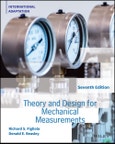Theory and Design for Mechanical Measurements provides a well-founded, fundamental background in the theory and practice of engineering measurements. Designed to align with a variety of undergraduate course structures, the book offers a rigorous treatment of the subject with a flexible pedagogical framework for use in graduate studies, independent study, or professional reference. It integrates the necessary elements to conduct engineering measurements through the design of measurement systems and measurement test plans, with an emphasis on the role of statistics and uncertainty analyses in that process. This International Adaptation offers new or expanded material on several topics, mostly under Fundamentals of Measurement, Systematic and Random Errors and Standard Uncertainties, Sensors and Actuators. Along with extensive coverage of device selection, test procedures, measurement system performance, the book includes practical discussion on real-world methods and techniques. The current applications of measurement theory and design are presented with examples, case studies, and vignettes. The updated end-of-chapter material includes significant number of new problems.
Table of Contents
1 FUNDAMENTAL OF MEASUREMENTS
1.1 Introduction
1.2 General Measurement System
1.3 Experimental Test Plan
1.4 Calibration
1.5 Standards
1.6 Presenting Data
1.7 Loading Effects
1.8 Applications of Measurement Systems
Summary
Nomenclature
References
Problems
2 STATIC AND DYNAMIC CHARACTERISTICS OF SIGNALS
2.1 Introduction
2.2 Input/Output Signal Concepts
2.3 Signal Analysis
2.4 Signal Amplitude and Frequency
2.5 Fourier Transform and the Frequency Spectrum
Summary
References
Suggested Reading
Nomenclature,
Problems
3 MEASUREMENT SYSTEM BEHAVIOR
3.1 Introduction,
3.2 General Model for a Measurement System
3.3 Special Cases of the General System Model
3.4 Transfer Functions
3.5 Phase Linearity
3.6 Multiple-Function Inputs
3.7 Coupled Systems
Summary
References
Nomenclature
Subscripts
Problems
4 PROBABILITY AND STATISTICS
4.1 Introduction
4.2 Statistical Measurement Theory
4.3 Describing the Behavior of a Population
4.4 Statistics of Finite-Sized Data Sets
4.5 Hypothesis Testing
4.6 Chi-Squared Distribution
4.7 Regression Analysis
4.8 Data Outlier Detection
4.9 Number of Measurements Required
4.10 Monte Carlo Simulations
4.11. Maximum Likelihood Theory
Summary
References
Nomenclature
Problems
5 ERRORS AND UNCERTAINTY ANALYSIS
5.1 Introduction
5.2 Measurement Errors
5.3 Design-Stage Uncertainty Analysis
5.4 Identifying Error Sources
5.5 Systematic and Random Errors and Standard Uncertainties
5.6 Uncertainty Analysis: Multi-Variable Error Propagation
5.7 Advanced-Stage Uncertainty Analysis
5.8 Multiple-Measurement Uncertainty Analysis
5.9 Correction for Correlated Errors
5.10 Nonsymmetrical Systematic Uncertainty Interval
Summary
References
Nomenclature
Problems
6 ANALOG ELECTRICAL DEVICES AND MEASUREMENTS
6.1 Introduction
6.2 Analog Devices: Current Measurements
6.3 Analog Devices: Voltage Measurements
6.4 Analog Devices: Resistance Measurements
6.5 Loading Errors and Impedance Matching
6.6 Analog Signal Conditioning: Amplifiers
6.7 Analog Signal Conditioning: Special-Purpose Circuits
6.8 Analog Signal Conditioning: Filters,
6.9 Grounds, Shielding, and Connecting Wires
Summary
References
Nomenclature
Problems
7 SAMPLING, DIGITAL DEVICES, AND DATA ACQUISITION
7.1 Introduction
7.2 Sampling Concepts
7.3 Digital Devices: Bits and Words
7.4 Transmitting Digital Numbers: High and Low Signals
7.5 Voltage Measurements
7.6 Data Acquisition Systems
7.7 Data Acquisition System Components
7.8 Analog Input-Output Communication
7.9 Digital Input-Output Communication
7.10 Digital Image Acquisition and Processing
Summary
References
Nomenclature
Problems
8 TEMPERATURE MEASUREMENTS
8.1 Introduction
8.2 Temperature Standards and Definition
8.3 Thermometry Based on Thermal Expansion
8.4 Electrical Resistance Thermometry
8.5 Thermoelectric Temperature Measurement
8.6 Radiative Temperature Measurements
8.7 Physical Errors in Temperature Measurement,
Summary
References
Suggested Reading
Nomenclature
Problems
9 PRESSURE AND VELOCITY MEASUREMENTS
9.1 Introduction
9.2 Pressure Concepts
9.3 Pressure Reference Instruments
9.4 Elastic Pressure Transducers
9.5 Pressure Transducer Calibration
9.6 Pressure Measurements in Moving Fluids
9.7 Modeling Pressure-Fluid Systems
9.8 Design and Installation: Transmission Effects
9.9 Acoustical Measurements
9.10 Fluid Velocity Measuring Systems
Summary
References
Nomenclature
Problems
10 FLOWMEASUREMENTS
10.1 Introduction
10.2 Historical Background
10.3 Flow Rate Concepts
10.4 Volume Flow Rate through Velocity Determination
10.5 Pressure Differential Meters
10.6 Insertion Volume Flow Meters
10.7 Mass Flow Meters
10.8 Flow Meter Calibration and Standards
10.9 Estimating Standard Flow Rate
Summary
References
Nomenclature
Problems
11 STRAIN MEASUREMENT
11.1 Introduction
11.2 Stress and Strain
11.3 Resistance Strain Gauges
11.4 Strain Gauge Electrical Circuits
11.5 Practical Considerations for Strain Measurement
11.6 Apparent Strain and Temperature Compensation
11.7 Optical Strain Measuring Techniques
Summary
References
Nomenclature
Problems
12 MECHATRONICS: SENSORS, ACTUATORS, AND CONTROLS
12.1 Introduction
12.2 Sensors
12.3 Actuators
12.4 Controls
Summary
References
Nomenclature
Problems
A PROPERTY DATA AND CONVERSION FACTORS
B LAPLACE TRANSFORM BASICS
B.1 Final Value Theorem
B.2 Laplace Transform Pairs
C Standard Normal Table
Reference
GLOSSARY
INDEX








